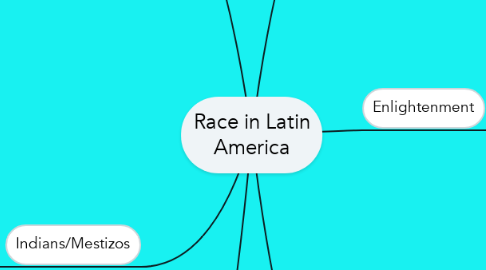
1. The Impact of the French and Haitian Revolutions
1.1. The Haitian Revolution was a turning point in history.
1.1.1. It had been Haiti's mission to teach the world the dangers of slavery and the latent powers and capabilities of the black race.
1.1.2. "The Haitian Revolution impinged in one way or another on the entire emancipation debate from the British parliamentary move in 1792 to outlaw the African slave trade to Brazil's final abolition of slavery ninety-six years later."
1.2. In the 1780's the French colony of Saint Domingue was the centerpiece of the Atlantic slave system.
1.2.1. Between 1791 and 1804, it was destroyed by revolution and civil war, ignited by the French Revolution.
2. Enlightenment
2.1. All people had the same natural rights
2.2. Latin America's criollo elites used the same language to articulate their need for freedom from Spain or Portugal
2.2.1. Criollo is non-mixed whites born in the new world
2.3. The belief in equality furthered the notion that people should govern themselves
2.4. Locke's three natural rights "Life, Liberty, and the Pursuit of Happiness"
2.4.1. 1. Life: everyone is entitled to live once they are created
2.4.2. 2. Liberty: everyone is entitled to do anything they want to so long as it doesn't conflict with the first right
2.4.3. 3. estate: everyone is entitled to own all they create or gain through the gift or trade
2.5. Gave us a racial thinking that made possible racism
2.6. The criollo elites didn't want change unless it was political
3. Mexican Independence
3.1. began as a drive by criollos for a change of the political order
3.2. Spain was able to retain control over its colony
3.2.1. the elites withdrew their support for the revolution
3.3. France invaded Spain
3.4. When General Augustin de Iturbide decided that breaking with Spain was the only way to avoid a liberal political order, Mexican Independence soon followed in 1821
3.5. 19th Century Mexico
3.5.1. Mexico's elite was divided into conservatives and liberals
3.5.2. "Was the new republic to be a federalist or centralist system?"
3.5.3. General Antonio Lopez de Santa Anna was a caudillo, also known as a dictator
3.5.4. Mexico suffered from foreign intervention and civil war
3.5.4.1. they lost more than 60% of their territory
3.5.4.2. Mexico was weakened
3.5.5. denial of the existence and impact of Afro Mexicans
4. Revolutionary Mexico (1910-1919)
4.1. Three revolutions broke out
4.1.1. 1. Liberal elites demanded political change
4.1.2. 2. This one was about land involving natives and peasants. The Zapatistas demanded land to the tiller
4.1.3. 3. This was led by Francisco "Pancho" Villa. This revolution was about justice for Mexico's ranch hands, vaqueros, and lower urban classes
4.2. The liberal elites took political control of Mexico
4.3. Governments refused to deal with the issue of discrimination
5. Indians/Mestizos
5.1. the process of mestizaje, sometimes seen as basically racial, is in fact social
5.1.1. mestizo is an achieved status
5.2. Central Mexican communities are deemed mestizos
5.3. one third of mexico's population was Indian at the time of the revolution
5.4. Subjective nature of Indians/mestizo status
5.4.1. Indians are socially define
5.5. Community is Indian if they feel like they're Indian regardless what their cultural is
5.5.1. An Indian is one who feels as if they belong to an indigenous community
5.6. Spanish and Indian culture mix
5.7. Indigenismo
5.7.1. not Spanish or Mestizo
5.7.2. All the Indian communities, languages, and groups were categorized.

